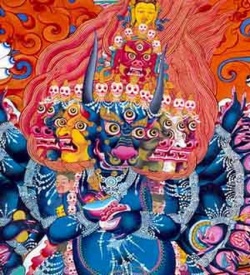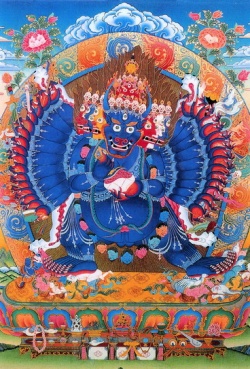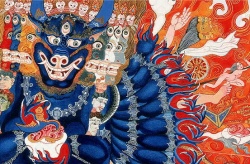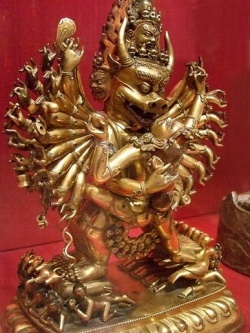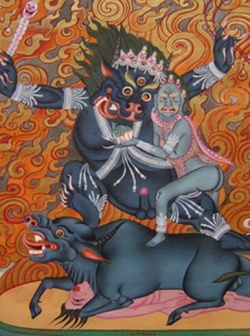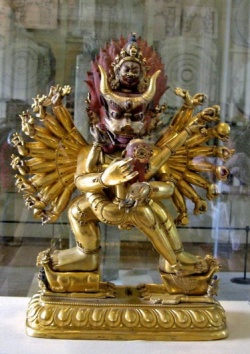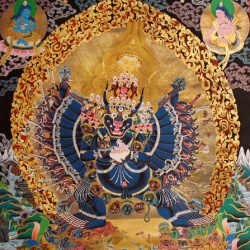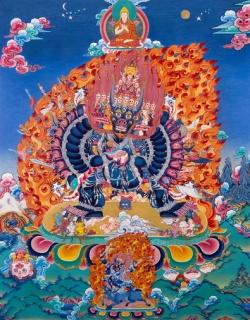Vajrabhairava
- In Vajrayana Buddhism, Vajrabhairava, also known as Yamantaka, is (1) a wrathful, buffalo-headed meditational deity (Tib
- yi-dam) of the Highest Yoga Tantra class and/or (2) a dharma protector.
Vajrabhairava is one of the principal three meditational deities of the Gelug school (Tib: gsang bde 'jigs gsum; the others are Chakrasamvara and Guhyasamaja).
He is also one of the main yidams in the Sakya school where he comes in a variety of appearances (with different mandalas). In both schools Vajrabhairava is seen as the wrathful manifestation of Manjushri, the buddha of wisdom.
In the other schools of Tibetan Buddhism Yamantaka seems to be mostly revered as a protector.
The (mostly secret and arcane) practices there involve different activities for various purposes. There are also some Yamantaka terma revelations in the Nyingma and Kagyu schools.
From amongst the many lineages of practice to enter Tibet the main transmissions of Vajrabhairava were those of the two translators Ra Lotsawa and Mal Lotsawa.
Although practiced early on in Tibet by the Sakya and Kagyu Traditions, it was Tsongkapa, founder of the Gelug Tradition, who instituted Vajrabhairava as the principal Gelugpa meditation practice.
In Sanskrit "Vajrabhairava" stands for 'Adamantine Terrifier'. Regardless which manifestation of Vajrabhairava you are looking at it he is always depicted as fear-inducing, scary, and intimidating.
Not only is he terrifying to look at but - according to the Vajrabhairava Tantra - he also has conquered all evil spirits, including the Lord of Death, Yama.
That's why he is also called "Yamantaka", the Slayer of Death.
Depending on which manifestation of Yamantaka the Tibetans call him either gSin-rje-gsed or in the buffalo-faced aspect of Vajrabhairava rdo-rje 'jigs-byed.
It seems that the term "Yamantaka" (and "Yamari") is used in a more general way than "Vajrabhairava" which is restricted to the buffalo-headed yidam of the Gelug and Sakya schools .
Sometimes the protector Kalarupa is called "Yamaraja" and comes as Outer, Inner, and Secret Yama- or Dharmaraja. In the Gelug school Yama- or Dharmaraja is part of the Vajrabhairava practice.
Multiple Forms of Vajrabhairava / Yamantaka
The Ngor Mandala collection of the Sakya tradition alone lists eight different forms/lineages of the blue/black buffalo-faced Vajrabhairava (which include the two Gelug ones) and four of red Rakta- or blue Krishna-Yamari (all without the buffalo head).
All the former are yidams (=meditational deities) whereas Yamaraja (sometimes also called Dharamaraja) is a Dharma protector.
Inner and Outer Yamaraja are blue/black, the Secret Yamaraja is red in color; Outer and Secret have buffalo heads, the Secret Yamaraja does not. There is also an emanation of Yamantaka (called Yamantaka or Yamantakrt) in the Ten Wrathful Ones / Uncommon Protection Wheel in the Vajrabhairava and Guhyasamaja practices.
Other emanations of Yamantaka appear as residents in the various mandalas (13-, 17-, 21-, and 49-Deity).
They all embody the wrathful aspect of peaceful Manjushri; Yamnataka's consort, Vajravetali the wrathful nature of Saraswati.
The Roar of Thunder:
The Roar of Thunder is a collection of texts related to the practice of Vajrabhairava Yamantaka.
The first text in this collection is a commentary to the Thirteen Deity Vajrabhairava practice composed by Ngulchu Dharmabhara.
This text is truly phenomenal and gives rich and inspiring instruction by combining both the Ensa and Segyu lineage of instructions in a straightforward yet incredibly profound presentation.
The second is a commentary to the Solitary Hero practice and was composed by the Fifth Ling Rinpoche, Losang Lungtog Tenzin Trinlay while he was in a three year Yamantaka retreat.
This text is a treasure trove of oral instructions that have not been written down elsewhere and is written for yogis of Yamantaka therefore its presentation is very down to earth and direct. </poem>
The form of Yamantaka represented here is known as Ekavira, the "Solitary Hero".
The Sanskrit term Vajrabhairava means the "Adamantine Terrifier" and Yamantaka means "Remover of the Obstacle Yama (the Judge of the Dead)."
This impressive sculpture, done in wood and finished with multi-colored lacquer, has a height of 52.25 inches (132 cms).
Collected by the American artist George Grey Barnard, in Tibet, before World War II, for many years it was on loan to the Museum of Natural History in New York and is now in the permanent collection of the Virginia Museum, Richmond.
It has been radiocarbon dated at between 1150 to 1290 C.E., which is the early Yuan period, falling comfortably within the reign-period of Kublai becoming Supreme Khan and Emperor of Mongolia and China (in 1260 C.E.).
Immediately following Kublai Khan's becoming Supreme Emperor, Karma Pakshi (1204-1283) the second Karmapa hierarch traveled to China, spending six years there and became the Supreme Teacher of this Emperor.
It is known that Kublai was initiated into the mysteries of Yamantaka.
The date-range of this magnificent Tantric sculpture also falls comfortably in the period of the Nepalese Master sculptor/artist Aniko's long stay in China at the request of Kublai.
The unusual iconography, style, choice of materials and overall effect of this impressive image suggests that it is indeed a masterwork done by Aniko or his immediate entourage.
THIS TANTRIC VISION
This 34-armed, 16-legged awesome form of Ekavira Vajrabhairava Yamantaka has a central bulls head with long black horns and the body colored deep dark blue-black.
The main and largest head wears a tiara of human skulls surmounted by an elaborate five-fold gilded crown embellished with the Buddhist "Wheel of Law" motif.
Above, the hair stands on end and is treated much like the style seen in Mahakala images - "with scorpion-sting shaped tips." The mouth is open wide to reveal teeth, a lolling tongue and large red lips.
The eyes are large, protruding and blood-shot, a "third eye" located at the center of the forehead.
The eyebrows are angrily knitted and elaborately raised and gilded. In total there are eight main heads - a yellow one to the proper right, a red one to the left, followed by others of pink, white/grey and blue - plus a ninth small crowned red head of the Bodhisattva Manjusri at the apex. These nine heads are in Tantric texts, linked to the nine classic "sentiments."
The central main hands of the deity hold a chopping-knife (karttrka) and human skull-bowl (kapala), colored gold and ornamented by pearl chains, flammiforms and scepters (vajra).
The lower main hands hold a magical knife (purba) and the severed multi-faced head of Brahma the Creator.
The upper main hands hold a red right hand holding an arrow and an elaborately decorated golden shield with a Chinese-style makara or dragon face at the center.
The other hands hold a ritual scepter (vajra), lance, axe, double-drum (damaru), Wheel of Law (dharmachakra), dagger, swirling flames, ritual bell (ghanta), skeleton-staff (khatvanga), banner, a red human right foot, a transfixed corpse, various magical knives and stakes, a noose, a skin, and other Tantric weapons.
The deity wears snake-bracelets, an elaborate chain and pearl motif looped necklace, armbands, an intricate draped girdle, anklets and other Dharmapala ornaments done in a style normally seen in the Yongle-period bronzes of Yamantaka and Mahakala.
Everywhere the decoration, done in raised gilded lacquer and/or wood, is lavishly finished.
A garland of human heads of different types and colors is threaded on an iron band draped around the neck of the deity and descending almost to the ankles. Seen from the back and sides, the massivity of this subject is all the more apparent.
The layers of legs and arms convey a feeling of hallucinatory exuberance; the pair of legs at the extreme back are off the podium, as if in dance.
The main legs are in the alidhasana posture, the row of right legs bent at the knee and the left legs straight.
This pose, taken from classical Indian dance, is common in sculpture and dance from Eastern India, especially Orissa.
The deity stands on the back of a row of birds (under the proper left foot), animals (a horse, a bull) and a man (under the right foot), and four small figures plus a large bird in obeisance can be seen on the podium.
Together, they all represent the "four ancient classes of beings" (birds, animals, humans and gods).
The three seated figures are the Hindu "trinity" of gods - a multi-headed Brahma holding an elixir-vase, a single-headed Vishnu and a multi-headed Shiva. The large bird is the Garuda, spiritual vehicle of Vishnu.
The human figure on one knee in front of the left foot of the deity almost certainly is the donor king or prince who originally commissioned the icon.
He wears a crown and the armor of a Mongol warrior and may be a portrait of Kublai himself.
The lotus podium is of a most unusual type. Generally one sees double lotus podiums, one above the other, and if single, the lotus petals point downwards. The row of single upward-turned lotus petals on the base of this icon go all around.
The petals are modeled in the typical early Yuan fashion, with elaborate swirling formalized patterns repeated and the tips of the petals protruding outwards. Each petal has its design raised, embellished and colored.
A row of "pearls" of even size encircles the upper part of the podium. The podium top is lacquered Imperial red.
The hands and feet have protruding nails or claws, and an elaborately draped scarf, done in red on the inside and decorated with Imperial gold flowers and foliate motifs, and of dark blue and gold on the outside reaches from behind the head of the deity to just above the feet.
THE MYTHIC BACKGROUND
In ancient Iranian mythology Yima, the first man, is cast out of Paradise, perhaps because of an incestuous liaison with his sister, Yimak.
In the Vedas of India there are suggestions that Yama and Yami were once an Original Being, a primordial hermaphrodite couple. The Rig Veda tells how Yama's twin sister Yami attempts to seduce him but is rejected.
In the Upanishads Yama is presented as the "Virile Lord", a little wild perhaps, a "husband of women and lover of maidens", while also serving as "Judge of the Dead".
King Yam or "Yam Raj", the "God of Death" of popular Hinduism, is also the Great Instructor into the mysteries of life and the hereafter. Yama is described as being like a dark male buffalo, or in human shape as a dark man riding a male buffalo and holding a club or staff.
His domain was supposed to be "in the South".
Interestingly, the aboriginal Bhil tribal peoples of India, who are dark complexioned, treat Yam Raj as a great god and call him by the name "Zom" in their language.
They say that Zom and his sister exchange special presents on particular days and believe that at death the soul follows Zom's orders.
Yama becomes connected to the Bhairava or wrathful form of Shiva in the Hindu Tantric tradition.
This form of dread and terror was assumed after Shiva decapitated Brahma the Creator.
Brahma's head became Shiva's begging bowl, which finally fell from his hand at Varanasi, where he overcomes Time (kala) to become Mahakala, the Great Black One, popularly known to Tantric Yogis as "Kal Bhairav".
Yama's sister Yami is associated with the sacred river Yamuna, connected to the main Subtle Channel (nadi) on the left, the "Path of Death".
She is further associated with Chamunda (the emaciated yogini and Mother Goddess of the cremation-ground) and Durga (the mystic form of Shiva's consort Uma/Parvati/Kali).
The eight Bhairava-forms of Shiva (named ;
<poem>
Krodha,
Kapali,
Canda,
Ruru,
Samhari,
Asitanga,
Bhisana and
Unmatta
in one tradition) have the eight Mother Goddesses (matrikas) as magical consorts or "sisters", and are further connected to eight Great Cremation-grounds which become the main places for Tantric initiation and are usually depicted around the outer edge of Tantric mandala paintings from Nepal and Tibet, whenever a wrathful form is at the center.
The Hindu rites of Yama are generally supposed to be necromantic and take place at midnight during the dark of the month, in the cremation-grounds.
The dark wrathful Yogi of Shaivite style - with hair wild and matted, eyes red and bulging from intoxicants, body covered with funeral ashes, draped in animal skins and snakes, holding a trident and eating from a human skull-bowl - become an icon of initiation, a Mahakala or Bhairava, who can take the seeker through the dark mysteries of death and into the clear light of Self-realization.
The confrontational and spontaneous initiatory approach of the Indian Siddha Yogis has been well documented in history and at the present time.
Some Tibetans who had the fortitude and courage to reach India and seek out Tantric Masters in the sacred cremation-grounds must have experienced Yama as an awesome initiatory vision which remained with them for always.
Knowledge of the mysteries of death are the goal of all higher mystic practices.
Those of Buddhist inclination saw Yama as Yamantaka, "Remover of the Obstacle of Death", as a "Protector of the Buddhist Dharma" and the "Ultimate Judge of all Karmic acts".
Madanjeet Singh, author of a fine book on Himalayan Art and culture, retells the popular Tibetan story as to how Yamantaka got his bull's head:
"The origin of the bull-head is ascribed to the tradition which speaks of a holy man who lived in a cave, practicing meditation. As he was about to achieve his objective and enter nirvana, two thieves with a stolen bull entered the cave and slaughtered it.
When they saw the ascetic, a witness to their crime, they beheaded him too.
But to their astonishment, the victim lifted the head of the bull and replacing his own severed head with it, became the ferocious form of Yama.
He then not only devoured the two thieves, but his insatiable thirst for human blood threatened the whole population.
The followers of the Vajrayana, therefore, appealed to Manjusri who, then assuming the fierce bull-headed form of Yamantaka, defeated Yama in a fearful struggle."
THE ICONOGRAPHY
"Yamantaka is an important deity in both the 'old' and 'new' Tantra traditions. The clear and penetrating wisdom of Yamantaka is the slayer of death."
According to R. P. Anuruddha:
"During the late Gandhara period (circa 6th century C.E), which we may regard as the time in which the first attempts were made to elaborate a rich figurative mythology of Mahayana Buddhism, occurred a tendency to divide the Tutelary Deities (istadevatas or yidams) into angry and mild forms."
He continues:
"The Yidams are represented in their fierce forms with hair standing on end, with wild-looking, outstanding eyes (and the 'third eye', the Eye of Wisdom in the middle of the forehead, between the two eye-brows), the hanging-out tongue, terrible teeth, and a short body, thick members and long nails on hands and feet."
The Guhyasamaja Tantra describes a scenario in which the (Tantric) Buddha emanates an initiatory mandala, placing four forms of Yamantaka in the four "gates".
The form of Yamantaka, placed in the all-important East, from which direction the sun rises, is associated with the right arm of the practitioner (sadhaka) in the system of the Guhyasamaja Tantra. Anuruddha gives the following description of Yamantaka as given in the Sri Mahabhairava Tantra of the Kangjur: "The figure should have 16 feet, 14 pairs of hands, 9 heads. It is naked and of black color, the feet are in the walking attitude and of terrible sight, in such a way he must paint the picture. The first head in the center of the Yidam is that of a bull, and beside the right horn there are three faces, a blue, a red and a yellow one. All three are very fierce looking. Beside the left horn of the bull's face there should be painted a white, a grey and a black face. Between the two horns there should be a terrible looking red face, and above it a mildly angry face of Manjusri. The hands of the Yidam hold the knife (gri-gug), a pointed weapon, a pestle, another knife, a dagger with the handle in the shape of a vajra, an axe and a conch-shell, an arrow and an iron hook, a cart stone, the club khatvanga, a chakra, a vajra, and a stone hammer, a sword, a damaru (hand-drum in the shape of an hour-glass); the left hands hold a human skull, a hand, a shield, a leg, a lasso, a bow, intestines, a bella hand, cloth from a cemetery, a man hanging upon a lance, an oven, a piece of a skull, a menacing finger, a trident with ribbons, a waving piece of cloth, etc. etc."
Though this description does not precisely conform to the Barnard Yamantaka, which has more arms and attributes, it is very close.
Three main forms of Yamantaka are revered by Tibetans: Vajrabhairava Yamantaka, who is multicolored; Raktayamari, who is red colored; and Krishnayamari, of black color. Tibetan paintings of Yama as the "King of the Death Lords", usually depict him with a bull's head, three-eyed, mouth open and tongue lolling, standing naked upon a bull and with his red penis erect. He wears the ornaments of a Dharma-Protector plus a garland of heads and holds a staff or noose. Other versions show him accompanied by his sister Yami, who is generally called "Tsamundi" (Chamunda) in the liturgy. Yama can also be seen in sexual union with a consort much like him, but of diminutive size.
The Sadhanamala, an important compilation of Indian Vajrayana sadhanas contemporary with several Siddhas succinctly states:
"Lord Yamari (Yamantaka) is of dignified appearance, internally compassionate but externally terrific for the good of all beings."
Professor Fokke Sierksma, author of a fascinating if controversial book on Tibet's angry deities mentions the position of the original Nyingmapa sect as regards Yamantaka:
"The biography of Padmasambhava even speaks of a Yama Tantra, while Yamantaka's near-absence is quite noticeable. It is even related that in the oldest monastery, Samye, the '300 reflections on Yamantaka' with other Tantras, were not translated, but laid aside."
It is however a fact that Yamantaka was known to Nyingmapa lamas and protective spells, amulets and charms of this sect frequently include mantras to propitiate this wrathful deity. The "Great Empowerment Wheel of the Lord of Death", the "Scorpion Empowerment Protection Wheel", the "Great Voidness Expelling and Empowerment Treasury Wheel" as well as several versions of the "Lamas Heart Wheel" (Nying Thig) are examples of Nyingmapa-originated printed charms which carry extensive Yamantaka liturgies.
According to the Tangjur, a huge collection of Vajrayana writings translated from Sanskrit into Tibetan, one of the main Indian gurus of the Yamantaka teachings was Vairochana Rakshita (circa 728-764 C.E), a disciple of Padmasambhava and author of the Vajrabhairava Mandalavidhi Prakasa. Other important Vajrabhairava transmissions came from Ratnakara Shanti (circa 978-1030 C.E) author of the Vajrabhairava Ganachakra and the Krishnayamari Sadhana, Abhayakaragupta (circa 1084-1130 C.E), Sridhara, Sri Krishnaraja (author of the Krsnayamari Tantra) and Krishnapada.
Krishnacaryya, another Tantric Master and contemporary to Siddhas Jalandhari and Gopichandra (who probably flourished in the early 8th century), "introduced the Tantras in which the male and female divinities sit clasping each other" (ref. Pag Som Jon Zan of Taranatha). Jnanamitra, though not generally categorized as a Siddha, taught the Yamantaka Tantra (a "Father" Tantra, which emphasizes Method through understanding and experiencing the Illusory Body) and also visited the Jagannatha Hindu temple in Orissa. Other Yamantaka lineage holders include Siddha Saraha, Siddha Lawapa, Siddha Virupa and Siddha Kukuri (aka Kukuripa). The Siddha Lalitavajra is said to have "taken the form of Yamantaka and cleft a mountain with a sword, so as to make a passage through." A "Yamantakaraja" personage is credited with initiating him into the important Guhyasamaja Tantra.
THE SCULPTOR
In 1260 C.E., a very versatile and talented young Nepalese artist named Aniko headed a group of Nepali artists and craftsmen invited to the Mongol court on the recommendation of Lama Phags-pa. Aniko met and impressed Kublai Khan and was commissioned to undertake a number of projects including the design and creation of a gigantic stupa, large images and many paintings.
Aniko's influence on Chinese Lamaist art was tremendous. He spent many years in China, trained a talented Chinese artist named Liu Yuan, and also worked on projects in collaboration with his own son, Acengge. In 1299 the Emperor commissioned Aniko to undertake 191 images and 64 paintings. And in 1304 a further 181 images were renewed and restored by him. Though little that survives can definitely be credited to Aniko's hand, this important artist and sculptor was surely responsible for introducing specific techniques, conventions and materials from Nepal.
